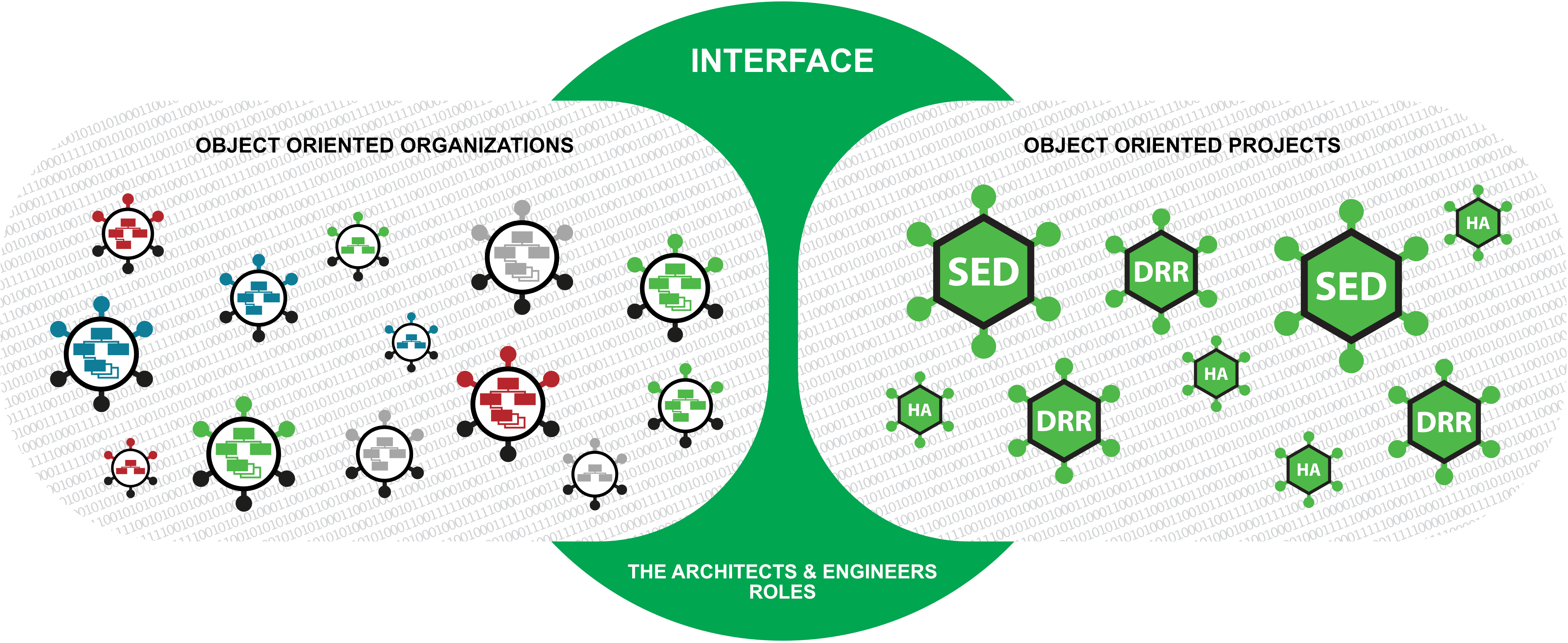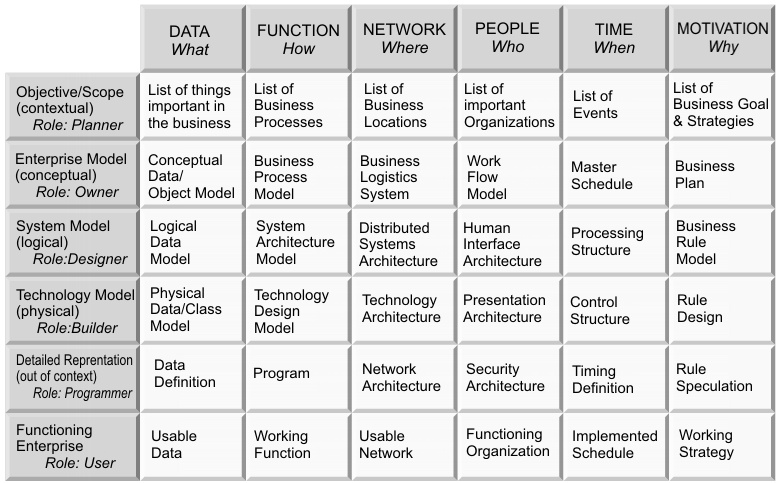Figure C4e.2 Interface of object-oriented organizations and projects, and architects

Enterprise architect
The Enterprise Architect (EA) has traditionally been responsible for the maintenance and upkeep of an IT organization.
It is strengthening ground in scaling organizational processes, building enterprise data structures, and digitizing manufacturing and business operations. Responsible for overseeing, improving, and upgrading business services, software, and hardware. Enterprise architecture is the most recognized discipline that:
Defines, organizes, standardizes, and documents the entire architecture and all critical elements of the relevant organization, covering relevant domains such as business, digital, physical, or organizational.
Ensures relationships and interactions between elements that belong to these domains, such as processes, functions, applications, events, data, or technologies.
The enterprise architecture fulfills the conceptual plan of development, flexibility, and functioning of the organization (through analysis, planning, design, and possible implementation of complex ICT changes in the organization).
The enterprise architecture supports proactive and holistic management of business responses and responds to disruptive forces by identifying and analyzing shifts towards the desired business vision and results.
Supports management in making recommendations to adjust policies and projects to achieve targeted business results that benefit from relevant business interruptions). In the available literature, enterprise architecture is not too much associated with preparing and implementing the organization's development projects. This activity or service belongs to the discipline of project management.
Data architect
In short, corporate architect (EA) responsibilities are overarching across the enterprise. At the same time, Data Architect (DA) has a subset of corporate architect responsibilities that focus primarily on the data itself (in the sense of the EA and DA relationship).
DA is responsible for the visualization and design of the organization's enterprise data management framework and is involved in the design, creation, deployment, and management of the organization's data architecture. This context describes the processes used to plan, specify, authorize, create, retrieve, maintain, use, archive, retrieve, manage, and clean up data.
DA is an expert in data architecture, a data management discipline that deals with the design, creation, deployment, and management of an organization's data architecture and are usually responsible for the visualization and structure of an organization's enterprise data management framework.
They are a professional responsible for defining the policies, procedures, models, and technologies to collect and organize the store and corporate access information (note that DA's position is often confused with database architect and data engineer). Data engineers are responsible for applying these policies and procedures through specific implementations of the database management system.
Data engineers tend to have a constant relationship with database design and management. In comparison, data architects influence higher-level decisions about relationships between data and operations, which can change less often. The synergy of both professionals covers the needs of organizations and projects in Figure C4e.1.
Project architect
The project Architect (PA) is the team leader responsible for overseeing the timely and profitable completion. The project architect coordinates the work team, consults with clients, and is responsible for the overall development and implementation of a specific architectural project. What is the difference between a project manager and an architect?
The project architect oversees the design process during the life cycle, while the manager oversees the planning and implementation phases. While the two works have many differences, the experts often work together. They have a common goal to achieve the project's overall objectives. PA is associated with construction projects.
These projects may involve two architectural practices (or more than one architect from the same practice). A design architect (sometimes called a "conceptual architect") is usually entrusted with implementing a creative design. He is responsible for planning the building, its space and overall appearance, and its relationship to its surroundings.
The project architect (sometimes called the "work architect") develops these broad conceptual designs into a detailed plan, ensuring that the final work is technically entirely constructed following the architect's concept vision and the client's vision.
PA functions usually include on-site surveys, the creation of a set of construction (or 'working') drawings for contractors and local authorities that meet building regulations in terms of structure, thermal, fire, acoustic, and hygiene criteria, etc.
It is followed by detailed plans, sections, views, constructions, and other drawings that enable the structure of the building and related technologies. It also deals with entries and additions to drawings, documentation specifications, materials requirements, construction procedures, and construction and assembly technology.
Communicate with the local authority (e.g., organize construction supervision before, during, and after construction). Coordinates inputs from stakeholders and suppliers (e.g., supply chain failures). It maintains quality controls properly, primarily on-site during project implementation.
They keep a list of minor defects or omissions in connection with the administration of contracts he is responsible for and direct links to project managers in any matter of more enormous (significant) faults or threats.
Zachman framework
The Zachman framework is an example of procedures that allow (give the ability) to classify an organization's architecture. It is a proactive business tool that can model existing functions, elements, and processes of an organization while helping to manage business change.
The Zachman Framework is an enterprise ontology and is the core structure of the Enterprise Architecture, which provides a formal and structured way to view and define a business. It represents a two-dimensional classification scheme that reflects the intersection of two historical classifications (see table below).
Zachman's framework is not a methodology in that it does not imply any particular method or process for collecting, managing, or using the information it describes. It is not a methodology; instead, it is an ontology whereby a schema for organizing architectural artifacts (in other words, design documents, specifications, and models).
The framework is a practical tool to consider who the artifact targets (for example, business owner and builder) and what particular issue (for example, data and functionality) is on an address of interest.
The framework has its name after its creator, John Zachman, who first developed the concept in the 1980s at IBM. It has been updated several times since then.

credit: https://commons.wikimedia.org/wiki/File:Zachman_Framework_Detailed.jpg
Figure C4e.2 schematically indicates two essential views on scaling. The first is the design of objects, and the second is the interface between the created things (objects). The method distinguishes between the creation of objects for organizations and projects.
For organizations, these are usually project portfolios profiled according to the target programs of the organization with a link to supplier and customer ties that the organization has or wants to change.
The most critical is for the interface between them to distinguish three different environments:
Enterprises in advanced countries.
Enterprises in middle-income countries.
Enterprises in low-income countries.
This division suggests the specifics of the absorption capabilities of the present population to receive the new technology (to understand them), to develop (to disseminate them by utilizing their added value), and apply (test them and gain experience on a global scale).
A more detailed view of the purpose is introduced in Figure C9c.In this context, we come to the various contents (terms) of the word architect or architecture. Generally, the architect is responsible for achieving a particular plan or aim.
This chapter's content distinguishes between traditional construction or arts architects and enterprise architects, data architects, or project architects. In connection to the Enterprise, it is helpful to understand the meaning of the Zachman framework.
Figure C4e.3 represents the Data Lake of organizations and Projects of a business environment in a hierarchy of three levels of influencers:
Space (e.g., solar flares impact on safety and sustainable functions of the ICT services in the Data Lake)
The Close Universe (e.g., spontaneous occupancy growth and risks for telecommunications and other satellites that condition the development and sustainability of Internet and G5 technologies in Data Lake),
Earth-Atmosphere, Continents, and sea (e.g., in the long history and present time lasting battles for territory, water, food, and, more recently, not only for oil and natural gas but also for deposits of precious metals, for political and financial power, which increasingly expands from national, territorial areas into the global dimension).
The critical relationship between organizations and projects is the supply and demand side chains that condition and form the quality growth or degradation. Figure C4e.3 presents a model of an organization and project chains.